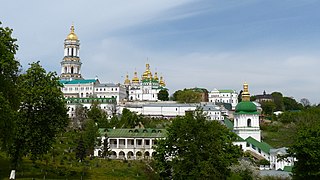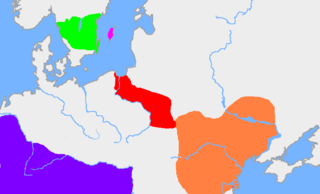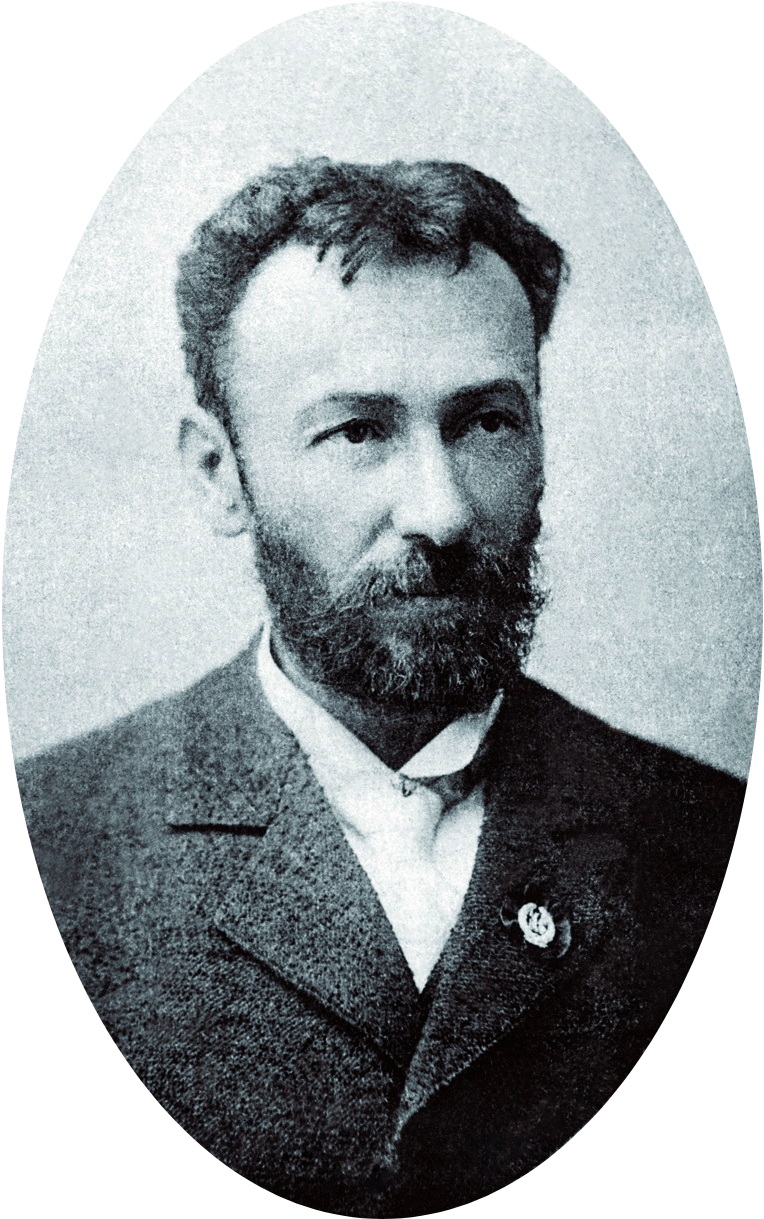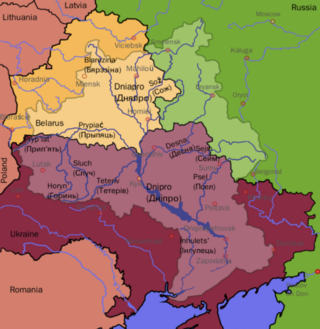
The East Slavs are the most populous subgroup of the Slavs. They speak the East Slavic languages, and formed the majority of the population of the medieval state Kievan Rus', which they claim as their cultural ancestor. Today Belarusians, Russians and Ukrainians are the existent East Slavic nations. Rusyns can also be considered as a separate nation, although they are often considered a subgroup of the Ukrainian people.

The Dnieper, also called Dnepr or Dnipro, is one of the major transboundary rivers of Europe, rising in the Valdai Hills near Smolensk, Russia, before flowing through Belarus and Ukraine to the Black Sea. Approximately 2,200 km (1,400 mi) long, with a drainage basin of 504,000 square kilometres (195,000 sq mi), it is the longest river of Ukraine and Belarus and the fourth-longest river in Europe, after the Volga, Danube, and Ural rivers.

Kaniv is a city in Cherkasy Raion, Cherkasy Oblast, central Ukraine. The city rests on the Dnieper River, and is one of the main inland river ports on the Dnieper. It is an urban hromada of Ukraine. Population: 23,172.

Kyiv is the capital and most populous city of Ukraine. It is in north-central Ukraine along the Dnieper River. As of 1 January 2022, its population was 2,952,301, making Kyiv the seventh-most populous city in Europe. Kyiv is an important industrial, scientific, educational, and cultural center in Eastern Europe. It is home to many high-tech industries, higher education institutions, and historical landmarks. The city has an extensive system of public transport and infrastructure, including the Kyiv Metro.

The Polans or Polians, also known as Polanians, Polianians, and Eastern Polans, were an East Slavic tribe between the 6th and the 9th century, which inhabited both sides of the Dnieper river from Liubech to Rodnia and also down the lower streams of the rivers Ros', Sula, Stuhna, Teteriv, Irpin', Desna and Pripyat.

The Przeworsk culture was an Iron Age material culture in the region of what is now Poland, that dates from the 3rd century BC to the 5th century AD. It takes its name from the town Przeworsk, near the village where the first artifacts were identified.

The Chernyakhov culture, Cherniakhiv culture or Sântana de Mureș—Chernyakhov culture was an archaeological culture that flourished between the 2nd and 5th centuries CE in a wide area of Eastern Europe, specifically in what is now Ukraine, Romania, Moldova and parts of Belarus. The culture is thought to be the result of a multiethnic cultural mix of the Geto-Dacian, Sarmatian, and Gothic populations of the area. "In the past, the association of this [Chernyakhov] culture with the Goths was highly contentious, but important methodological advances have made it irresistible."

Vydubychi Monastery is a historic monastery in the Ukrainian capital Kyiv. During the Soviet period it housed the NANU Institute of Archaeology.

The Zarubintsy, Zarubyntsi or Zarubinets culture was a culture that, from the 3rd century BC until the 1st century AD, flourished in the area north of the Black Sea along the upper and middle Dnieper and Pripyat Rivers, stretching west towards the Southern Bug river. Zarubintsy sites were particularly dense between the Rivers Desna and Ros as well as along the Pripyat river. It was identified around 1899 by the Czech-Ukrainian archaeologist Vikentiy Khvoyka and is now attested by about 500 sites. The culture was named after finds of cremated remains in the village of Zarubyntsi on the Dnieper.

Vikentiy Viacheslavovych Khvoyka was an archaeologist who discovered the Neolithic Trypillia culture of Ukraine. He also researched the Scythian, Zarubintsy, Chernyakhov and early Slavic archaeological cultures.

Berezan is an island in the Black Sea at the entrance of the Dnieper-Bug Estuary, Mykolaiv Raion, Mykolaiv Oblast, Ukraine. Located 8 kilometers from the city of Ochakiv and 4 kilometers from the resort village of Rybakivka. It is often being confused with the artificial island of Pervomaisky that is located within Dnieper-Bug Estuary. The Berezan island measures approximately 900 metres in length by 320 metres in width, the height of the northern part is 3-6 metres, the southern part is 21 metres. It is separated from the mainland by about a mile and a half of shallow water. Berezan is an integral part of the historical and archaeological reserve of the National Academy of Sciences of Ukraine "Olvia". The island is uninhabited. In the summer, archaeological expeditions of the IA NASU and the State Hermitage Museum work here. The archaeological site is regularly destroyed as a result of unauthorized excavations.

The Milograd culture is an archaeological culture, lasting from about the 7th century BC to the 1st century AD. Geographically, it corresponds to present day southern Belarus and northern Ukraine, in the area of the confluence of the Dnieper and the Pripyat, north of Kyiv. Their ethnic origin is uncertain, but likely to be either Baltic or Early Slavic.

The Dnieper Balts were a subgroup of the Balts that lived in the Dnieper river basin for millennia until the Late Middle Ages, when they were partly destroyed and partly assimilated by the Slavs by the 13th century. To the north and northeast of the Dnieper Balts were the Volga Finns, and to the southeast and south were the ancient Iranians, the Scythians.
The most important phenomenon that took place within the lands of Poland in the Early Middle Ages, as well as other parts of Central Europe was the arrival and permanent settlement of the West Slavic or Lechitic peoples. The Slavic migrations to the area of contemporary Poland started in the second half of the 5th century AD, about a half century after these territories were vacated by Germanic tribes fleeing from the Huns. The first waves of the incoming Slavs settled the vicinity of the upper Vistula River and elsewhere in the lands of present southeastern Poland and southern Masovia. Coming from the east, from the upper and middle regions of the Dnieper River, the immigrants would have had come primarily from the western branch of the early Slavs known as Sclaveni, and since their arrival are classified as West Slavs and Lechites, who are the closest ancestors of Poles.[a]
Maidanetske is a village located within the Zvenyhorodka Raion (district) of the Cherkasy Oblast (province), about 235 kilometers (146 mi) driving distance south of Kyiv. It belongs to Talne urban hromada, one of the hromadas of Ukraine.
Rusʹ Khaganate, or kaganate of Rus is a name applied by some modern historians to a hypothetical polity suggested to have existed during a poorly documented period in the history of Eastern Europe between c. 830 and the 890s.

The early Slavs were speakers of Indo-European dialects who lived during the Migration Period and the Early Middle Ages in Central, Eastern and Southeast Europe and established the foundations for the Slavic nations through the Slavic states of the Early and High Middle Ages. The Slavs' original homeland is still a matter of debate due to a lack of historical records; however, scholars generally place it in Eastern Europe, with Polesia being the most commonly accepted location.

Batyieva Hora is a former village, and now a historical neighbourhood in the Solomianskyi District of Kyiv, the capital of Ukraine. It is located on the right bank of the Dnieper, on the side of the hill above the river Lybid. Burial grounds of Zarubintsy culture dated in the 2nd-4th century AD were discovered in Batyieva Hora.

Volyntsevo culture or Volyntseve culture is an archaeological culture of the early Middle Ages, located between the Dnieper and the Don rivers. In the west, the territory of the Volyntsevo monuments reaches the right bank of Dnieper in the Kyiv area. Dmytro Berezovets identified the culture, and named it after the village of Volyntseve in Sumy Oblast of Central Ukraine, which he excavated in 1948–1950.


















